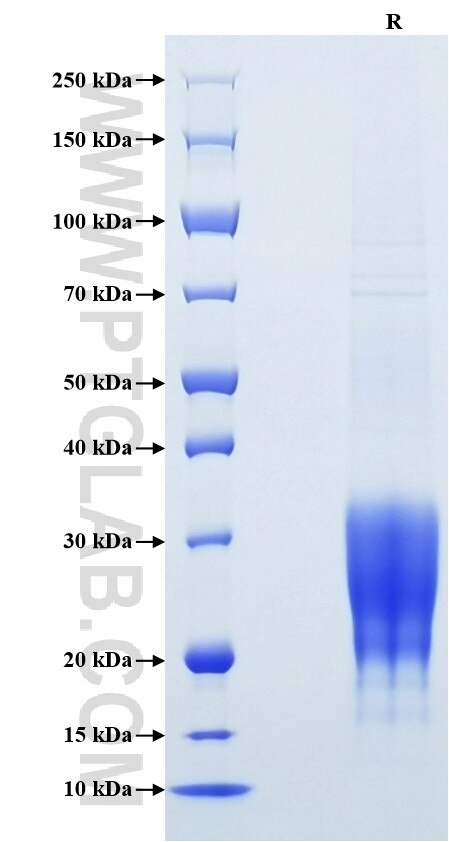Recombinant Mouse IFN-gamma/IFNG protein (His Tag)
Species
Mouse
Purity
>90 %, SDS-PAGE
Tag
His Tag
Activity
not tested
Cat no : Eg0334
Validation Data Gallery
Product Information
| Purity | >90 %, SDS-PAGE |
| Endotoxin | <0.1 EU/μg protein, LAL method |
| Activity |
Not tested |
| Expression | HEK293-derived Mouse IFN-gamma protein His23-Cys155 (Accession# P01580) with a His tag at the C-terminus. |
| GeneID | 15978 |
| Accession | P01580 |
| PredictedSize | 19.3 kDa |
| SDS-PAGE | 20-35 kDa, reducing (R) conditions |
| Formulation | Lyophilized from 0.22 μm filtered solution in PBS, pH 7.4. Normally 5% trehalose and 5% mannitol are added as protectants before lyophilization. |
| Reconstitution | Briefly centrifuge the tube before opening. Reconstitute at 0.1-0.5 mg/mL in sterile water. |
| Storage Conditions |
It is recommended that the protein be aliquoted for optimal storage. Avoid repeated freeze-thaw cycles.
|
| Shipping | The product is shipped at ambient temperature. Upon receipt, store it immediately at the recommended temperature. |
Background
The IFNs were originally discovered as agents that interfere with viral replication. Initially, they were classified by the secreting cell type but are now classified into type I and type II according to receptor specificity and sequence homology. Interferon gamma (IFN-γ) is a soluble cytokine that is the only member of the type II class of interferons. It is secreted by Th1 cells, cytotoxic T cells and NK cells. The cytokine is associated with antiviral, immunoregulatory and anti-tumor properties and is a potent activator of macrophages. It plays crucial roles in pathogen clearance. Aberrant Ifng expression is associated with a number of autoinflammatory and autoimmune diseases. It has been identified in many studies as a biomarker for pleural tuberculosis (TB). Mutations in this gene are associated with aplastic anemia.
References:
1. Isaacs, A. et al.(1957). The interferon Proc. R. Soc. Lond. B Biol. Sci. 147: 258-267. 2. Gray PW. et al. (1982). Nature. 298 : 859-63. 3. Bullens, D. M. et al.(2001). Int. Immunol. 13: 181-191. 4. Wang Z. et al.(2014). Biosci Biotechnol Biochem.78: 588-92. 5. Chegou NN. et al.(2012). PLoS One.7(6):e38501

